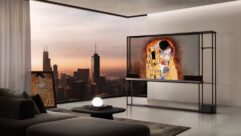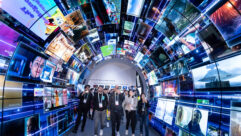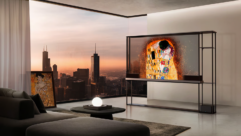CES: Cheaper, Bigger, More Colorful
Although it’s primarily a consumer show, many products on display at CES will eventually work their way into pro AV.
Trend to watch: lower flat-panel pricesTrend to watch: larger flat-panel sizesTrend to watch: enhancements to TFT-LCD performanceTrend to watch: competing flat-panel technologies
OTHER TRADE shows ebb and flow from year to year, but the Consumer Electronics Show (CES), held in early January in Las Vegas, continues to grow exponentially. While it’s officially a consumer show, many products on display will inevitably wind up in the pro AV channel. And what a bevy of products, from pocket projectors to super-sized plasmas, flat-screen TVs with built-in digital video recorders, and LCD monitors with LED backlights.
With all the booths featuring televisions, set-top boxes, video servers, video recorders, DVD players, and a host of go-between magic boxes, it was hard to know where to start. The major players showed up as they always do, but there were numerous “who’s that?” companies showing flat-panel TVs — many of which were made in China.
For the past few years, the Korean companies led by Samsung and LG pushed and pulled their way to better market share with incessant price slashing. Now, the “big three” Chinese manufacturers (Chi Mei Optoelectronics, AU Optoelectronics, and Chunghwa Picture Tube) are pulling the same trick, flooding the market with LCD and plasma products while driving down prices and margins for everyone. Examples include 42-inch LCD (1280×768) and HD plasma (1024×768) TVs with integrated digital tuners (no CableCARD) for $2,500, 46-inch HD (1366×768) plasma TVs with similar tuners for $3,500, and 50-inch plasma TVs (with digital tuners) for just more than $5,000.
BenQ joined the 46-inch LCD club with its DV4680, which sells for about $3,000 less than comparable Samsung and Sony products and includes a digital TV tuner for ATSC broadcasts. (In fact, many of the larger LCD and plasma TVs are following the FCC mandate and including ATSC tuners, although not always CableCARD slots.)
We all know about Samsung, Pioneer, LG, Panasonic, NEC, Fujitsu, and Hitachi, but how many Pro AV readers have ever heard of Norcent, Erae, Sampo, Moxell, Vizio, or Westinghouse Digital?
They’re all U.S. trading companies that are importing flat screens from Taiwan and China (sometimes even Korea) by the boatload, helping to drive prices down even more. All of these companies (plus veterans Optoma and BenQ) exhibited dozens of models of plasma and LCD monitors and TVs at CES.
The flat-panel giants aren’t conceding anything in this market. Samsung showed an enormous 102-inch plasma TV (Z-102) and is also shipping its 80-inch HP-R8072. Down the hall, LG had its 71-inch MW-71PY10 plasma TV out for inspection, along with a large-screen LCD version, the 55-inch 55LP1D.Sharp stole some of Samsung’s thunder with its largest-in-class Aquos 65-inch LCD TV, putting this technology neck and neck with plasma in all mainstream screen sizes. However, it’s not likely you’ll see too many of these for sale soon as the large LCD mother-glass used to make this panel is better put to use in multiple 32-inch and 45-inch sections.
The battle for flat-panel supremacy continues on other fronts. Philips has come up with a scanning LCD backlight for a few of its LCD TVs, both as an energy conservation measure and as a way to minimize motion blur, something from which all TFT-LCD monitors and TVs suffer.
JVC has also hatched a different scheme to improve perceived motion response and it’s called Genessa. It uses 32-bit processing to drive a quick-shot panel driver, and the demo appeared to work quite well.
Samsung and Sony showed there’s more than one way to get better color out of TFT-LCD monitors by using light-emitting diodes (LEDs) to produce a pair of drop-dead beautiful 46-inch 1920×1080 monitors. Samsung’s version is the LNR460D and it’s claimed to achieve 105 percent of the NTSC/SMPTE-C color gamut. (Sony’s Qualia 005 version is essentially the same product.)
Think the plasma manufacturers are concerned about LCD technology? Panasonic executives prepared an elaborate presentation and demonstration of the advantages of plasma over LCD. Their position was that LCD would hold the market below 32 inches, LCD and plasma would co-exist between 32 and 37 inches, and plasma would rule above that mark.
My position has been for some time that LCD will take over the market up to 42 inches before very long, and nothing I saw and heard about at CES leads me to believe otherwise. (The truth is, most consumers don’t know the difference between LCD and plasma technology and don’t care — all they’re focused on is price.)
Perhaps the most interesting flat-panel product at CES wasn’t even on the floor, but privately demonstrated by Canon and Toshiba. It’s called the surface-conduction electron-emitter display (SED). Think of it as a super-flat CRT with similar operating voltages between the electron emitters and the anode (about 10 kV). A 36-inch prototype with deep, rich blacks, crisp motion, fine picture detail, and saturated CRT-like colors was used in the press demo. No pricing information was available, although Toshiba representatives claimed it would be competitive with plasma and LCD and that a 50-inch version would come to market soon. In terms of picture quality, it was no contest — the SED won hands down. But can it find a niche in the torrent of LCD and plasma products?
CES: Cheaper, Bigger, More Colorful
Although it’s primarily a consumer show, many products on display at CES will eventually work their way into pro AV.
Trend to watch: advancements in HTPSTrend to watch: digital interfaces
Incidentally, for those who thought tubes were on their way out the door, both LG and Samsung had demonstrations of super-thin widescreen CRTs. The Samsung models were only 14 inches deep, compared to the 20-inch models used in its current DTV sets. LG’s version requires just a tad more depth at 15.7 inches with a 30-inch wide screen.
At the back end of the LVCC South Hall was a large booth identified as “3LCD.” Sponsored by Sony, Panasonic, Hitachi, Epson, Fujitsu, and Sanyo, this booth featured both 720p and 1080p rear-projection TVs using high-temperature poly-silicon (HTPS) panels with a few 720p and 1080p front projectors on hand, too.
Why 3LCD? After years of ignoring Texas Instruments’ DLP promotional and branding efforts, the major players in LCD projector manufacturing decided they had to counter some of the negative buzz about HTPS. You could see just how far 3LCD technology has come at Fujitsu’s suite in the Venetian hotel. Its LPF-D711W front LCD projector looked particularly clean and crisp and had excellent color saturation. This native 1080p front LCD projector will retail somewhere in the $25,000 range, putting it up squarely against Sony’s Qualia 004 SXRD and JVC’s DLA-HD2K LCoS offerings.
Speaking of LCoS, both Philips and Intel gave up trying to tame the LCoS beast earlier this year. But there are still plenty of other companies in the game, most notably Sony and JVC. Several LCoS manufacturers are active in China and a few new panels were announced at the show, including eLCOS’ VAN eHD70 0.7-inch diagonal panel. This 1920×1080 pixel imager is supposed to have 4,000:1 contrast and less than 10 ms response time.
The issue of color quality is also being addressed. PerkinElmer’s Cermax division had a demo at the Mirage Hotel of just how good its compact and economical xenon arc lamp can look in both front and rear projection LCD and DLP applications. These lamps, which can operate from about 300 W to 800 W, have far superior spectral output than UHP and related mercury-vapor lamps and make an enormous difference in flesh tone rendering.
For a clever sidebar demo, InFocus, BenQ, and Mitsubishi showed a trio of palm-sized “pocket DLP projectors.” The illumination source was sequentially switched red, green, and blue LEDs. Perhaps not bright enough to be practical, but they made for interesting concept products.
Silicon Image, which has the unenviable task of maintaining and updating the DVI and HDMI standards, has announced an HDMI interoperability program to ensure that HDMI-equipped DVD players, receivers, set-top boxes, and TVs actually work with each other. They’ve also come out with low-cost HDMI receivers and a brand-new HDMI-equipped video scaler and processor chip, the SiI 8100.
Look for more interface manufacturers to get with the program and bring out DVI and HDMI distribution amplifiers and switchers as Gefen has done. Most HDMI-equipped TVs and monitors only have one such input. Gefen’s products can expand that to four, and Silicon Image is showing new HDMI interface boards with two, three, and even four direct inputs for future products.
Pete Putman is a contributing editor for Pro AV and president of ROAM Consulting, Doylestown, PA. Especially well known for the product testing/development services he provides manufacturers of projectors, monitors, integrated TVs, and display interfaces, he has also authored hundreds of technical articles, reviews, and columns for industry trade and consumer magazines over the last two decades. You can reach him at [email protected].










